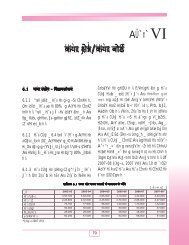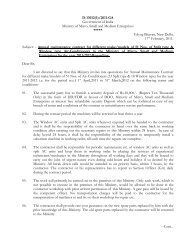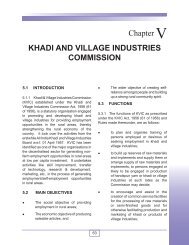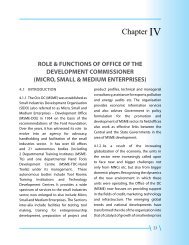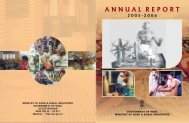Evaluation Study MSE Cluster Development - Ministry of Micro ...
Evaluation Study MSE Cluster Development - Ministry of Micro ...
Evaluation Study MSE Cluster Development - Ministry of Micro ...
Create successful ePaper yourself
Turn your PDF publications into a flip-book with our unique Google optimized e-Paper software.
Chapter No: 6 – Hard Interventions in Sampled <strong>Cluster</strong>shydel power apart from viable solar energy applications can be collectively pursuedthrough hard interventions. Moreover the recycling <strong>of</strong> waste, the use <strong>of</strong> valuable byproducts, and also the treatment <strong>of</strong> toxic effluents and wastes open up many usefulcollective options for both lowering unit costs and protecting the environment. Withincreasing environmental concerns come severe regulation and restrictions that are likelyto affect small and micro enterprises in particular as they can hardly take up theseinitiatives individually. The only way out seems to be collective action through hardinterventions. The Rice Milling <strong>Cluster</strong> in Kalady, and the Rubber <strong>Cluster</strong> inChenganacherry are examples <strong>of</strong> some such hard initiatives.Spreading or Collectively Sharing, Risks- Though it may be possible for an individualunit to set up a facility that he himself can use and also hire out to others, he would haveto be sure that the others use the facility so that the capacity which is created is fullyutilized. These are however risks involved in such a venture. It is therefore preferred toundertake such a project collectively so as to share the risks by spreading them over themembers <strong>of</strong> the SPV. The solvent extraction project taken up in the Rice Milling <strong>Cluster</strong>in Kallady was viable even at the level <strong>of</strong> an individual unit, as long as there wasadequate demand for this facility by millers other than the unit setting up the facility onan individual basis. The investment involved in plant and machinery was large but thereturns were also equally attractive, however considering the long-term viability <strong>of</strong> ricemilling in the state <strong>of</strong> Kerala, and also the uncertainty regarding the demand for theservices <strong>of</strong> this facility, the risks involved were substantial. The project was thuscommissioned in 2005 entirely as a privately led collective intervention in order to spreadthe risks as well as share the benefits among the private consortia/SPV that was formedfor the purpose. No support except for s<strong>of</strong>t interventions was provided for this projectunder the <strong>MSE</strong>-CDP programme, clearly demonstrating that the logic <strong>of</strong> the programmeand its impact are very robust and more importantly that hard interventions can besuccessfully carried out even without much support from the government.The Coir<strong>Cluster</strong> at Alleppey is yet another example <strong>of</strong> the effective sharing <strong>of</strong> risks andresponsibilities as well as the benefits among SPV members. Yet another interestingcase is that <strong>of</strong> several SPVs belonging to the Handloom <strong>Cluster</strong>, in Kannur, Kerala joininghands to invest in a common retailing outlet for products. This outlet was located in theexpensive up market locality in the city and involved large investments as well as risksthat were shared.Availing Benefits <strong>of</strong> State Support – State and State promotional agencies makesupport conditional to the formation <strong>of</strong> a legally constituted and accountable SPV. TheState <strong>of</strong>ten expects the equitable and widespread participation <strong>of</strong> cluster units and attimes clearly defines the minimum number <strong>of</strong> cluster units that are required to bemembers <strong>of</strong> the SPV formed for the proper channelization <strong>of</strong> State funds. Though hardnetworks/ SPVs can be based entirely on the basis <strong>of</strong> private involvement with no statesupport, it is seen that most <strong>Cluster</strong> <strong>Development</strong> Initiatives adopt the PPP mode. TheState is the ‘hand holder’ in the earlier stages <strong>of</strong> cluster development but progressivelytakes a ‘back seat’ as the cluster matures and becomes a self sustaining collective.107





